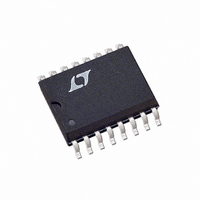LTC1149CS-5 Linear Technology, LTC1149CS-5 Datasheet - Page 9

LTC1149CS-5
Manufacturer Part Number
LTC1149CS-5
Description
IC SW REG STEP-DOWN 5V 16-SOIC
Manufacturer
Linear Technology
Type
Step-Down (Buck)r
Datasheet
1.LTC1149CNPBF.pdf
(20 pages)
Specifications of LTC1149CS-5
Internal Switch(s)
No
Synchronous Rectifier
Yes
Number Of Outputs
1
Voltage - Output
5V
Current - Output
50mA
Frequency - Switching
250kHz
Voltage - Input
0 ~ 48 V
Operating Temperature
0°C ~ 70°C
Mounting Type
Surface Mount
Package / Case
16-SOIC (3.9mm Width)
Lead Free Status / RoHS Status
Contains lead / RoHS non-compliant
Power - Output
-
Available stocks
Company
Part Number
Manufacturer
Quantity
Price
Part Number:
LTC1149CS-5
Manufacturer:
LINEAR/凌特
Quantity:
20 000
Part Number:
LTC1149CS-5#TRPBF
Manufacturer:
LINEAR/凌特
Quantity:
20 000
APPLICATIO S I FOR ATIO
Inductor Core Selection
Once the minimum value for L is known, the type of
inductor must be selected. High efficiency converters
generally cannot afford the core loss found in low cost
powdered iron cores, forcing the use of more expensive
ferrite, molypermalloy, or Kool M
loss is independent of core size for a fixed inductor value,
but it is very dependent on inductance selected. As induc-
tance increases, core losses go down. Unfortunately,
increased inductance requires more turns of wire and
therefore copper losses increase.
Ferrite designs have very low core loss, so design goals
can concentrate on copper loss and preventing saturation.
Ferrite core material saturates “hard,” which means that
inductance collapses abruptly when the peak design cur-
rent is exceeded. This results in an abrupt increase in
inductor ripple current and consequent output voltage
ripple which can cause Burst Mode operation to be falsely
triggered in the LTC1149 series. Do not allow the core to
saturate!
Molypermalloy (from Magnetics, Inc.) is a very good, low
loss core material for toroids, but it is more expensive than
ferrite. A reasonable compromise from the same manu-
facturer is Kool M . Toroids are very space efficient,
especially when you can use several layers of wire.
Because they generally lack a bobbin, mounting is more
difficult. However, new surface mount designs available
from Coiltronics do not increase the height significantly.
P-Channel MOSFET Selection
Two external power MOSFETs must be selected for use
with the LTC1149 series: a P-channel MOSFET for the
main switch, and an N-channel MOSFET for the synchro-
nous switch.
The minimum input voltage determines whether standard
threshold or logic-level threshold MOSFETs must be used.
For V
may be used. If V
level threshold MOSFETs (V
recommended. When logic-level MOSFETs are used, the
absolute maximum V
greater than the LTC1149 series internal regulator
voltage V
IN
> 8V, standard threshold MOSFETs (V
CC
.
IN
U U
is expected to drop below 8V, logic-
GS
rating for the MOSFETs must be
GS(TH)
®
< 2.5V) are strongly
W
cores. Actual core
GS(TH)
U
< 4V)
Selection criteria for the P-channel MOSFET include the
on-resistance R
input voltage and maximum output current. When the
LTC1149 is operating in continuous mode, the duty cycle
for the P-channel MOSFET is given by:
The P-channel MOSFET dissipation at maximum output
current is given by:
where is the temperature dependency of R
is a constant related to the gate drive current. Note the two
distinct terms in the equation. The first gives the I
losses, which are highest at low input voltages, while the
second gives the transition losses, which are highest at
high input voltages. For V
efficiency generally improves with larger MOSFETs
(although gate charge losses begin eating into the gains.
See Efficiency Considerations). For V
tion losses rapidly increase to the point that the use of a
higher R
higher efficiency. This is illustrated in the Design Example
section.
The term (1 + ) is generally given for a MOSFET in the
form of a normalized R
voltage MOSFETs. C
electrical characteristics. The constant K is much harder to
pin down, but K = 5 can be used for the LTC1149 series to
estimate the relative contributions of the two terms in the
P-channel dissipation equation.
N-Channel MOSFET and D1 Selection
The same input voltage constraints apply to the N-channel
MOSFET as to the P-channel with regard to when logic-
level devices are required. However, the dissipation calcu-
lation is quite different. The duty cycle and dissipation for
Kool M is a registered trademark of Magnetics, Inc.
= 0.007/ C can be used as an approximation for low
P-Ch Duty Cycle =
P-Ch P
DS(ON)
D
=
+ K(V
V
V
DS(ON)
device with lower C
LTC1149-3.3/LTC1149-5
OUT
IN
IN
RSS
)
(I
2
, reverse transfer capacitance C
(I
MAX
V
MAX
DS(ON)
is usually specified in the MOSFET
V
OUT
IN
)
2
)(C
IN
(1 +
vs temperature curve, but
RSS
< 24V, the high current
P
)(f)
RSS
) R
IN
DS(ON)
> 24V, the transi-
actually provides
LTC1149
DS(ON)
and K
RSS
9
2
R
,














